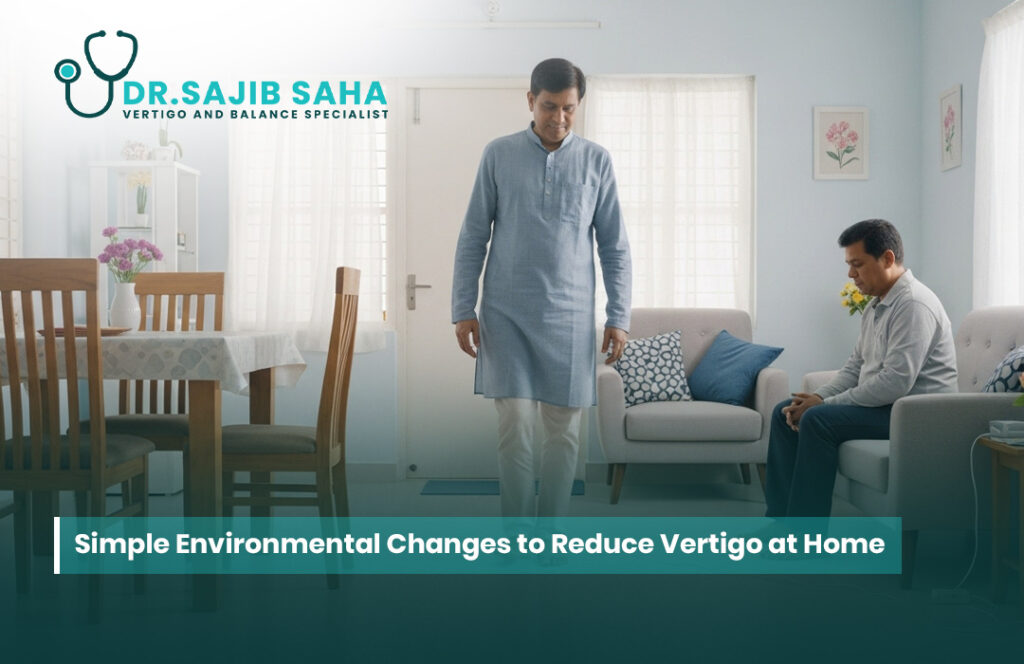Vertigo, characterized by a spinning sensation or imbalance, can significantly disrupt daily life. While medical evaluation and treatment are essential, simple environmental and lifestyle adjustments at home can play a crucial role in reducing the frequency and severity of vertigo episodes.
By creating a vertigo-friendly home environment, you can enhance safety, improve mobility, and regain confidence in your daily activities.
1. Optimize Lighting Throughout the Home
Poor or uneven lighting can exacerbate dizziness and increase fall risk.
-
Use bright, evenly distributed lighting in hallways, kitchens, bathrooms, and staircases.
-
Install motion-sensor night lights in key areas to safely navigate at night.
-
Avoid harsh glare or flickering lights, which can trigger disorientation in sensitive individuals.
2. Declutter and Organize Living Spaces
Cluttered spaces can be dangerous for individuals prone to vertigo or balance issues.
-
Remove unnecessary items from walkways, stairs, and high-traffic areas.
-
Arrange furniture to allow wide, unobstructed paths for easy navigation.
-
Label or organize frequently used items for quick and safe access, reducing sudden bending or reaching.
3. Prioritize Non-Slip Surfaces
Slips and falls are common triggers for vertigo-related accidents.
-
Place non-slip mats in bathrooms, kitchens, and near entryways.
-
Ensure all rugs have anti-slip backing.
-
Consider textured or cushioned flooring to provide additional grip and proprioceptive feedback.
4. Adapt Furniture and Safety Supports
Strategically modifying furniture can prevent sudden falls during vertigo episodes:
-
Install handrails near staircases, bathrooms, and other critical areas.
-
Use sturdy chairs with armrests to sit safely if dizziness occurs.
-
Keep essential items within arm’s reach to avoid sudden stretching or bending.
5. Maintain Comfortable Indoor Temperature
Rapid changes in temperature or extreme heat can worsen dizziness:
-
Avoid very hot showers or sudden exposure to cold drafts.
-
Use fans, air conditioning, or heaters to maintain a consistent and comfortable temperature.
-
Ensure proper air circulation to reduce feelings of lightheadedness.
6. Minimize Visual and Sensory Triggers
Certain visual stimuli can trigger or worsen vertigo:
-
Avoid busy, high-contrast patterns on walls or floors.
-
Reduce flickering lights from TVs or screens.
-
Keep decor simple and consistent to provide a stable visual environment.
7. Create Safe Rest and Recovery Areas
-
Identify safe zones in each room where you can sit or lie down if dizziness occurs.
-
Keep chairs or beds nearby in commonly used areas.
-
Add cushions or supportive pillows to reduce strain on the neck and spine.
8. Enhance Balance Through Environmental Cues
Small modifications can help your brain maintain spatial orientation:
-
Use contrast markers on stairs to clearly identify edges.
-
Place handrails or grab bars along hallways.
-
Ensure frequently used items are placed at eye level to prevent sudden neck movements.
9. Optimize Indoor Air Quality
-
Poor ventilation or exposure to strong odors can aggravate dizziness.
-
Keep windows open for fresh air, or use air purifiers to maintain clean indoor air.
-
Avoid smoking indoors and minimize exposure to chemicals or strong fragrances.
10. Develop Consistent Daily Habits
Lifestyle changes complement environmental modifications:
-
Rise slowly from beds or chairs to prevent sudden vertigo.
-
Perform gentle neck and balance exercises recommended by your doctor.
-
Avoid overexertion or rapid head movements that may trigger dizziness.
Professional Support Matters
While home adjustments significantly help, persistent or severe vertigo should always be evaluated by a specialist.
At Dr. Sajib Saha’s Vertigo & Balance Clinic in Dhaka, patients receive:
-
Comprehensive diagnostic assessments for inner ear, cervical spine, and neurological causes.
-
Personalized treatment plans, including vestibular rehabilitation, physiotherapy, and lifestyle guidance.
-
Expert advice on fall prevention and home safety strategies.
Conclusion
Vertigo can make daily life challenging, but a vertigo-friendly home environment can drastically reduce risk, enhance safety, and improve overall quality of life. By combining professional treatment with simple environmental adjustments, patients can regain confidence, move safely, and enjoy daily activities with fewer interruptions from dizziness.
Take Action Today: If you or a loved one experiences vertigo, consult Dr. Sajib Saha, one of Dhaka’s leading vertigo and balance specialists, to create a personalized plan for safe living at home.
